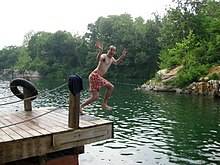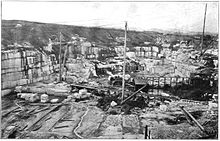Beaver Dam is a flooded marble quarry in Cockeysville, Maryland that has been used as a swimming location since the 1930s. Currently, a 30-acre swim club is located there with two swimming pools, a volleyball court, picnic tables and grills, a creek, and snack house. The 40 foot deep freshwater quarry has floating platforms, two rolling logs, diving and jumping platforms, and a rope swing.[1]


The quarry began operation in the 19th century and much of the labor was that of Irish immigrants using hand drills, hammers and chisels. In 1878, Hugh Sisson acquired the property and began using the latest equipment available: steam powered derricks, shovels, and diamond bit drills. Stone was loaded onto wagons and pulled by oxen to the nearby Northern Central Railway in Cockeysville until the quarry site itself was connected to the rail in 1866. The dolomitic marble, known to geologists as the Cockeysville Marble, from the quarry was used widely within the eastern United States, including the Washington Monument in Baltimore and the one in Washington, D.C.[2][3]
Notes
editReferences
edit- Craig, Tim (2001-07-07), "Parents of drowned woman file suit against Beaver Dam", Baltimore Sun, retrieved 2011-06-13
- Dam, Beaver (2011-06-13), "Beaver dam swimming club", Beaver Dam Swimming Club, archived from the original on 2011-06-02, retrieved 2011-06-13
- McCarthy, Ellen (2008-07-18), "Beaver Dam Swimming Club Review", The Washington Post, archived from the original on 2012-11-12, retrieved 2011-06-13
- McCausland, Christianna (2008-06-13), "Taking the Plunge", Baltimore Style, retrieved 2011-06-13